oil type VOLKSWAGEN UP! 2021 Owner´s Manual
[x] Cancel search | Manufacturer: VOLKSWAGEN, Model Year: 2021, Model line: UP!, Model: VOLKSWAGEN UP! 2021Pages: 211, PDF Size: 5.98 MB
Page 14 of 211
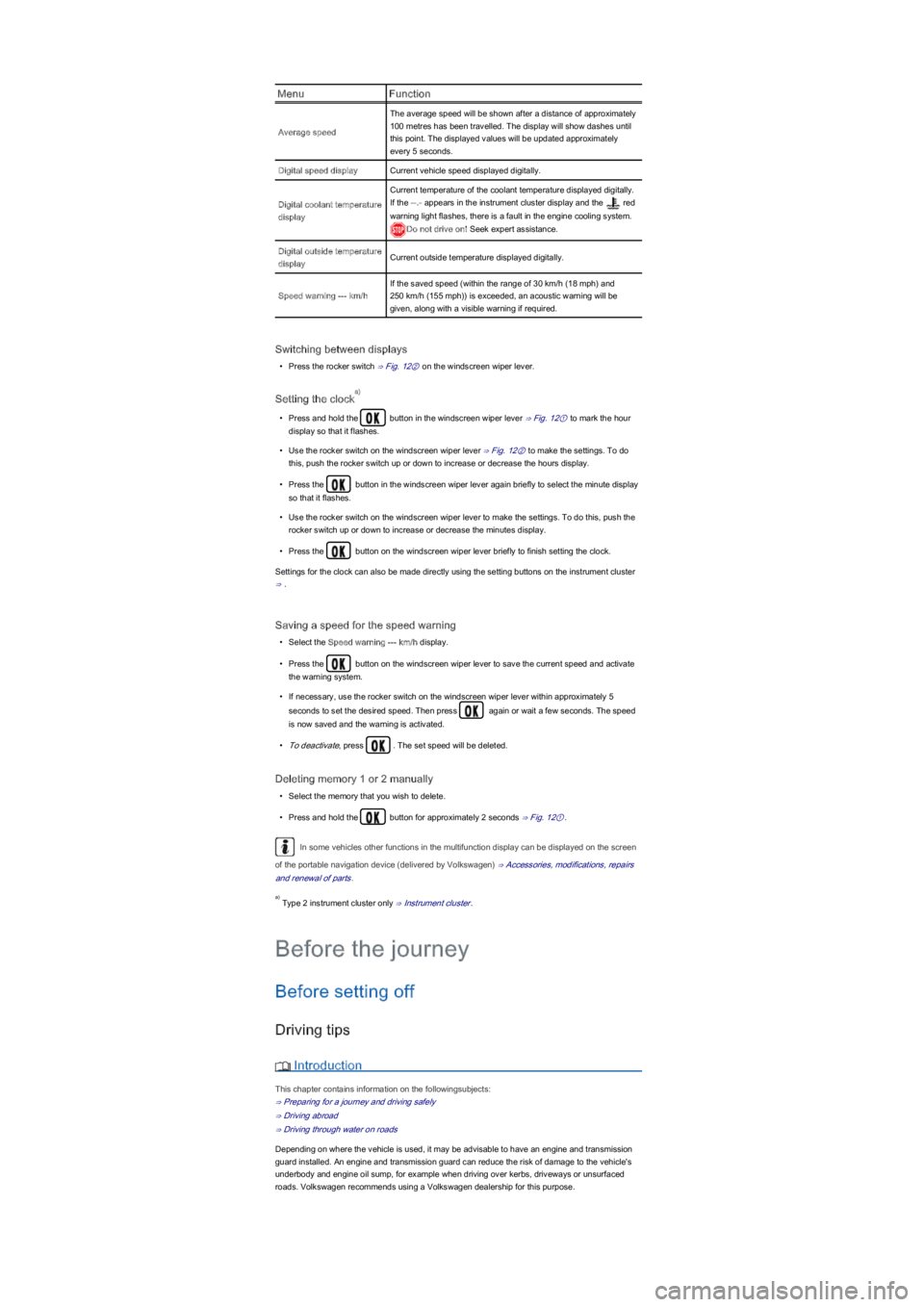
MenuFunction
Average speed
The average speed will be shown after a distance of approximately
100 metres has been travelled. The display will show dashes until
this point. The displayed values will be updated approximately
every 5 seconds.
Digital speed displayCurrent vehicle speed displayed digitally.
Digital coolant temperature
display
Current temperature of the coolant temperature displayed digitally.
If the --.- appears in the instrument cluster display and the red
warning light flashes, there is a fault in the engine cooling system.
Do not drive on! Seek expert assistance.
Digital outside temperature
displayCurrent outside temperature displayed digitally.
Speed warning --- km/h
If the saved speed (within the range of 30 km/h (18 mph) and
250 km/h (155 mph)) is exceeded, an acoustic warning will be
given, along with a visible warning if required.
Switching between displays
•Press the rocker switch ⇒ Fig. 12② on the windscreen wiper lever.
Setting the clock
•Press and hold the button in the windscreen wiper lever ⇒ Fig. 12① to mark the hour
display so that it flashes.
•Use the rocker switch on the windscreen wiper lever ⇒ Fig. 12② to make the settings. To do
this, push the rocker switch up or down to increase or decrease the hours display.
•Press the button in the windscreen wiper lever again briefly to select the minute display
so that it flashes.
•Use the rocker switch on the windscreen wiper lever to make the settings. To do this, push the
rocker switch up or down to increase or decrease the minutes display.
•Press the button on the windscreen wiper lever briefly to finish setting the clock.
Settings for the clock can also be made directly using the setting buttons on the instrument cluster
⇒ .
Saving a speed for the speed warning
•Select the Speed warning --- km/h display.
•Press the button on the windscreen wiper lever to save the current speed and activate
the warning system.
•If necessary, use the rocker switch on the windscreen wiper lever within approximately 5
seconds to set the desired speed. Then press again or wait a few seconds. The speed
is now saved and the warning is activated.
•To deactivate, press . The set speed will be deleted.
Deleting memory 1 or 2 manually
•Select the memory that you wish to delete.
•Press and hold the button for approximately 2 seconds ⇒ Fig. 12①.
In some vehicles other functions in the multifunction display can be displayed on the screen
of the portable navigation device (delivered by Volkswagen) ⇒ Accessories, modifications, repairs
and renewal of parts.
Type 2 instrument cluster only ⇒ Instrument cluster.
Before setting off
Driving tips
Introduction
This chapter contains information on the followingsubjects:
⇒ Preparing for a journey and driving safely
⇒ Driving abroad
⇒ Driving through water on roads
Depending on where the vehicle is used, it may be advisable to have an engine and transmission
guard installed. An engine and transmission guard can reduce the risk of damage to the vehicle's
underbody and engine oil sump, for example when driving over kerbs, driveways or unsurfaced
roads. Volkswagen recommends using a Volkswagen dealership for this purpose.
a)
a)
Before the journey
Page 17 of 211
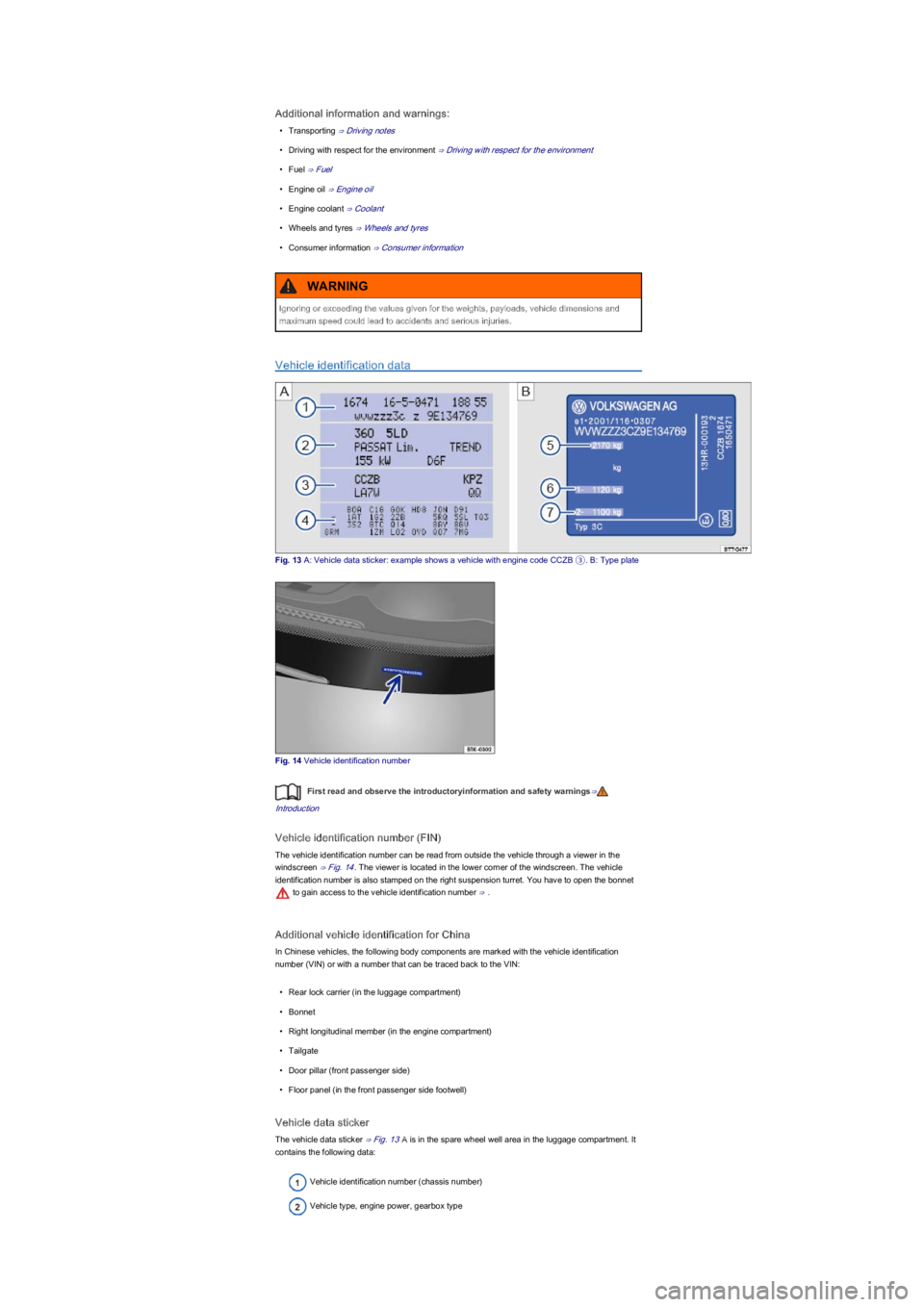
Additional information and warnings:
•Transporting ⇒ Driving notes
•Driving with respect for the environment ⇒ Driving with respect for the environment
•Fuel ⇒ Fuel
•Engine oil ⇒ Engine oil
•Engine coolant ⇒ Coolant
•Wheels and tyres ⇒ Wheels and tyres
•Consumer information ⇒ Consumer information
Vehicle identification data
Fig. 13 A: Vehicle data sticker: example shows a vehicle with engine code CCZB ③. B: Type plate
Fig. 14 Vehicle identification number
First read and observe the introductoryinformation and safety warnings⇒
Introduction
Vehicle identification number (FIN)
The vehicle identification number can be read from outside the vehicle through a viewer in the
windscreen ⇒ Fig. 14. The viewer is located in the lower corner of the windscreen. The vehicle
identification number is also stamped on the right suspension turret. You have to open the bonnet
to gain access to the vehicle identification number ⇒ .
Additional vehicle identification for China
In Chinese vehicles, the following body components are marked with the vehicle identification
number (VIN) or with a number that can be traced back to the VIN:
•Rear lock carrier (in the luggage compartment)
•Bonnet
•Right longitudinal member (in the engine compartment)
•Tailgate
•Door pillar (front passenger side)
•Floor panel (in the front passenger side footwell)
Vehicle data sticker
The vehicle data sticker ⇒ Fig. 13A is in the spare wheel well area in the luggage compartment. It
contains the following data:
Vehicle identification number (chassis number)
Vehicle type, engine power, gearbox type
Ignoring or exceeding the values given for the weights, payloads, vehicle dimensions and
maximum speed could lead to accidents and serious injuries.
WARNING
Page 19 of 211
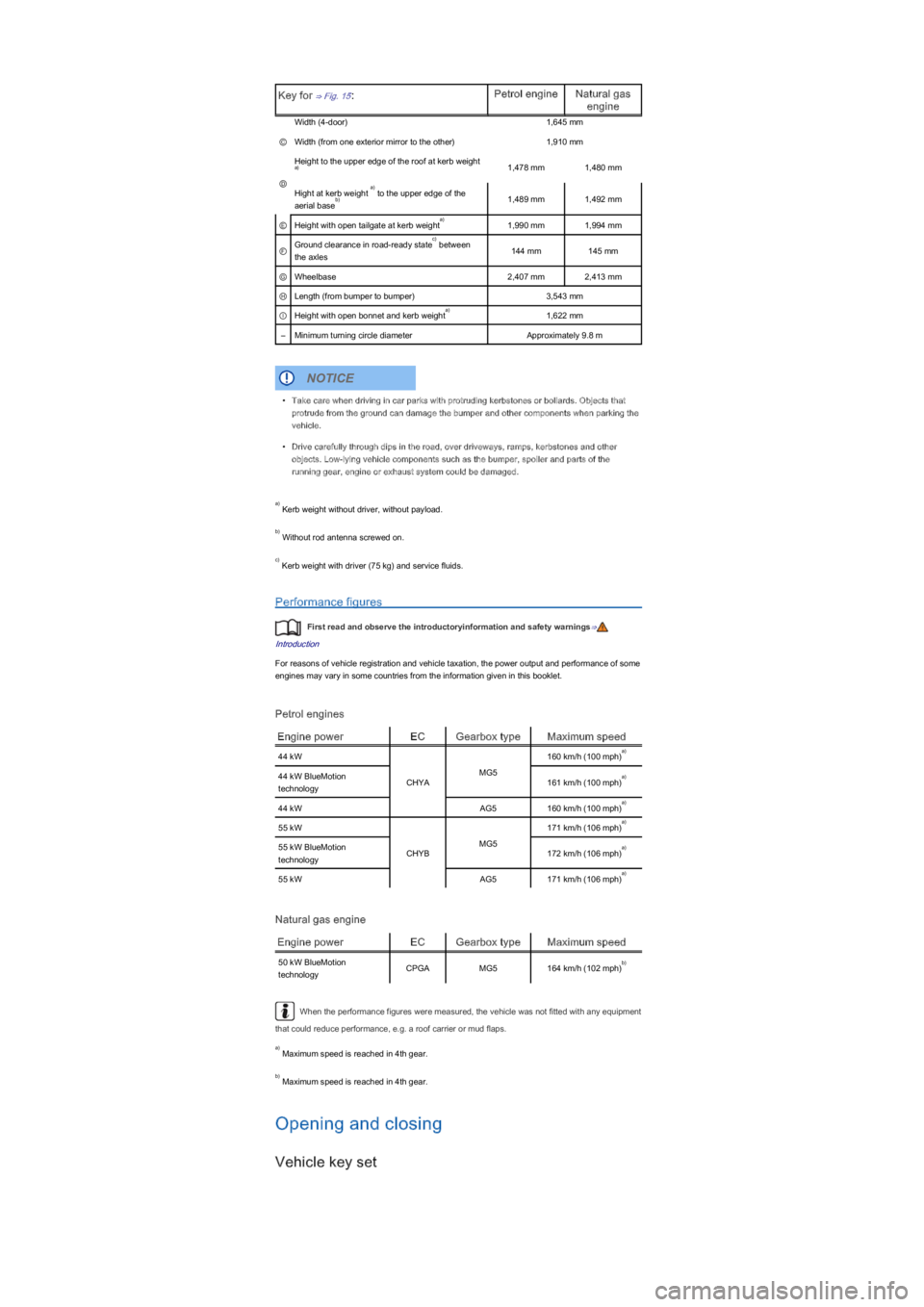
Key for ⇒ Fig. 15:Petrol engineNatural gas
engine
Width (4-door)1,645 mm
ⒸWidth (from one exterior mirror to the other)1,910 mm
Ⓓ
Height to the upper edge of the roof at kerb weight 1,478 mm1,480 mm
Hight at kerb weight to the upper edge of the
aerial base1,489 mm1,492 mm
ⒺHeight with open tailgate at kerb weight1,990 mm1,994 mm
ⒻGround clearance in road-ready state between
the axles144 mm145 mm
ⒼWheelbase2,407 mm2,413 mm
ⒽLength (from bumper to bumper)3,543 mm
ⒾHeight with open bonnet and kerb weight1,622 mm
–Minimum turning circle diameterApproximately 9.8 m
Kerb weight without driver, without payload.
Without rod antenna screwed on.
Kerb weight with driver (75 kg) and service fluids.
Performance figures
First read and observe the introductoryinformation and safety warnings⇒
Introduction
For reasons of vehicle registration and vehicle taxation, the power output and performance of some
engines may vary in some countries from the information given in this booklet.
Petrol engines
Engine powerECGearbox typeMaximum speed
44 kW
CHYA
MG5
160 km/h (100 mph)
44 kW BlueMotion
technology161 km/h (100 mph)
44 kWAG5160 km/h (100 mph)
55 kW
CHYB
MG5
171 km/h (106 mph)
55 kW BlueMotion
technology172 km/h (106 mph)
55 kWAG5171 km/h (106 mph)
Natural gas engine
Engine powerECGearbox typeMaximum speed
50 kW BlueMotion
technologyCPGAMG5164 km/h (102 mph)
When the performance figures were measured, the vehicle was not fitted with any equipment
that could reduce performance, e.g. a roof carrier or mud flaps.
Maximum speed is reached in 4th gear.
Maximum speed is reached in 4th gear.
Opening and closing
Vehicle key set
a)
a)
b)
a)
c)
a)
•Take care when driving in car parks with protruding kerbstones or bollards. Objects that
protrude from the ground can damage the bumper and other components when parking the
vehicle.
•Drive carefully through dips in the road, over driveways, ramps, kerbstones and other
objects. Low-lying vehicle components such as the bumper, spoiler and parts of the
running gear, engine or exhaust system could be damaged.
NOTICE
a)
b)
c)
a)
a)
a)
a)
a)
a)
b)
a)
b)
Page 129 of 211
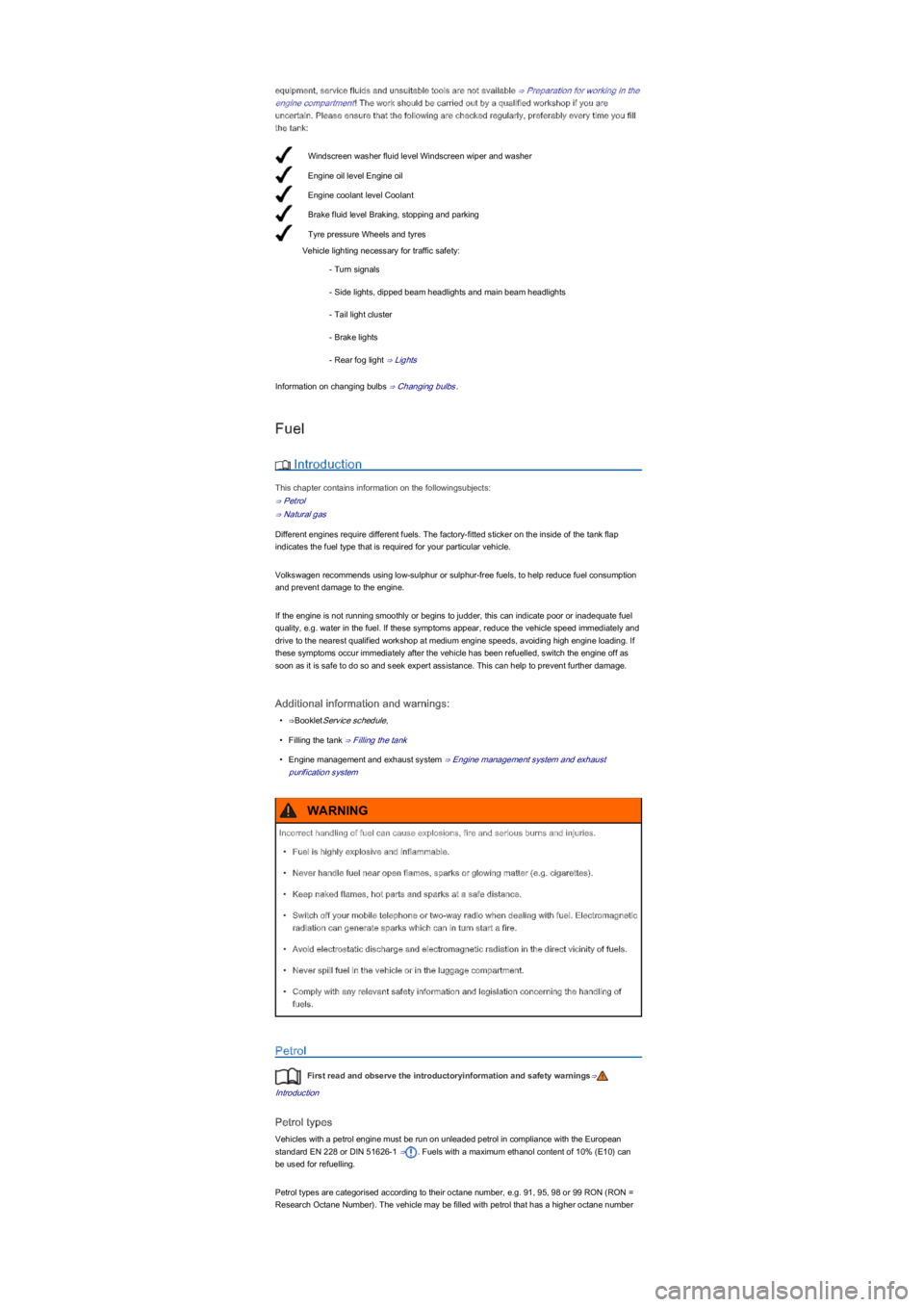
Windscreen washer fluid level Windscreen wiper and washer
Engine oil level Engine oil
Engine coolant level Coolant
Brake fluid level Braking, stopping and parking
Tyre pressure Wheels and tyres
equipment, service fluids and unsuitable tools are not available ⇒ Preparation for working in the
engine compartment! The work should be carried out by a qualified workshop if you are
uncertain. Please ensure that the following are checked regularly, preferably every time you fill
the tank:
Vehicle lighting necessary for traffic safety:
- Turn signals
- Side lights, dipped beam headlights and main beam headlights
- Tail light cluster
- Brake lights
- Rear fog light ⇒ Lights
Information on changing bulbs ⇒ Changing bulbs.
Fuel
Introduction
This chapter contains information on the followingsubjects:
⇒ Petrol
⇒ Natural gas
Different engines require different fuels. The factory-fitted sticker on the inside of the tank flap
indicates the fuel type that is required for your particular vehicle.
Volkswagen recommends using low-sulphur or sulphur-free fuels, to help reduce fuel consumption
and prevent damage to the engine.
If the engine is not running smoothly or begins to judder, this can indicate poor or inadequate fuel
quality, e.g. water in the fuel. If these symptoms appear, reduce the vehicle speed immediately and
drive to the nearest qualified workshop at medium engine speeds, avoiding high engine loading. If
these symptoms occur immediately after the vehicle has been refuelled, switch the engine off as
soon as it is safe to do so and seek expert assistance. This can help to prevent further damage.
Additional information and warnings:
•⇒BookletService schedule,
•Filling the tank ⇒ Filling the tank
•Engine management and exhaust system ⇒ Engine management system and exhaust
purification system
Petrol
First read and observe the introductoryinformation and safety warnings⇒
Introduction
Petrol types
Vehicles with a petrol engine must be run on unleaded petrol in compliance with the European
standard EN 228 or DIN 51626-1 ⇒. Fuels with a maximum ethanol content of 10% (E10) can
be used for refuelling.
Petrol types are categorised according to their octane number, e.g. 91, 95, 98 or 99 RON (RON =
Research Octane Number). The vehicle may be filled with petrol that has a higher octane number
Incorrect handling of fuel can cause explosions, fire and serious burns and injuries.
•Fuel is highly explosive and inflammable.
•Never handle fuel near open flames, sparks or glowing matter (e.g. cigarettes).
•Keep naked flames, hot parts and sparks at a safe distance.
•Switch off your mobile telephone or two-way radio when dealing with fuel. Electromagnetic
radiation can generate sparks which can in turn start a fire.
•Avoid electrostatic discharge and electromagnetic radiation in the direct vicinity of fuels.
•Never spill fuel in the vehicle or in the luggage compartment.
•Comply with any relevant safety information and legislation concerning the handling of
fuels.
WARNING
Page 136 of 211

If possible, only use Volkswagen-approved engine oil ⇒. The engine oils listed are multigrade
high-lubricity oils.
Engine oils are constantly being developed and improved. A Volkswagen dealership is always kept
up to date on innovations. Volkswagen therefore recommends having engine oil changes done by a
Volkswagen dealership.
The quality of the engine oil is not only tailored to the requirements of engines and exhaust gas
treatment systems, but also to fuel quality. Due to the way in which a combustion engine works,
engine oil always comes into contact with combustion residues and fuel, which has a knock-on
effect on the ageing process of the oil.
The quality of fuels can vary greatly between individual markets and this must be taken into account
when selecting the correct engine oil.
The use of engine oils compliant with the VW 504 00 requires a fuel quality compliant with EN 228
(petrol) or fuel of and equivalent quality. Engine oils compliant with VW 504 00 are therefore
unsuitable for use in a large number of markets.
Permitted engine oil
specifications ⇒
Alternative engine oil
specifications⇒
Engine
type
Fixed service QI1, QI2, QI3,
QI4, QI7 (based on
time/distance travelled)
Only in the EU, Switzerland,
Norway, Japan and Australia
Petrol
enginesVW 502 00VW 504 00
Natural gas
engineVW 502 00-----
Alternative engine oil specifications may only be used in fixed services QI1, QI2, QI3, QI4 and
QI7, and only when fuel of a quality compliant with EN 228 (petrol), or fuel of an equivalent quality,
is available in the particular country.
Checking the engine oil level and refilling engine oil
Fig. 121 Oil dipstick with markings
Fig. 122 In the engine compartment: engine oil filler cap
First read and observe the introductoryinformation and safety warnings⇒
Introduction
a)
•Do not add any additional lubricants to the engine oil. Any damage caused by the use of
such additives is not covered by the warranty.
•Only engine oil specifications that have been approved for use with the engine should be
used. Using other engine oils can cause engine damage.
•Another engine oil can be used in the event of an emergency if the listed engine oils () are
not available. To avoid damaging the engine, a maximum quantity of 0.5 litres of the
following engine oil may be used only once until the next oil change:
- Petrol engines: standards ACEAA3/B4 or API SN (API SM).
NOTICE
a)
Page 154 of 211
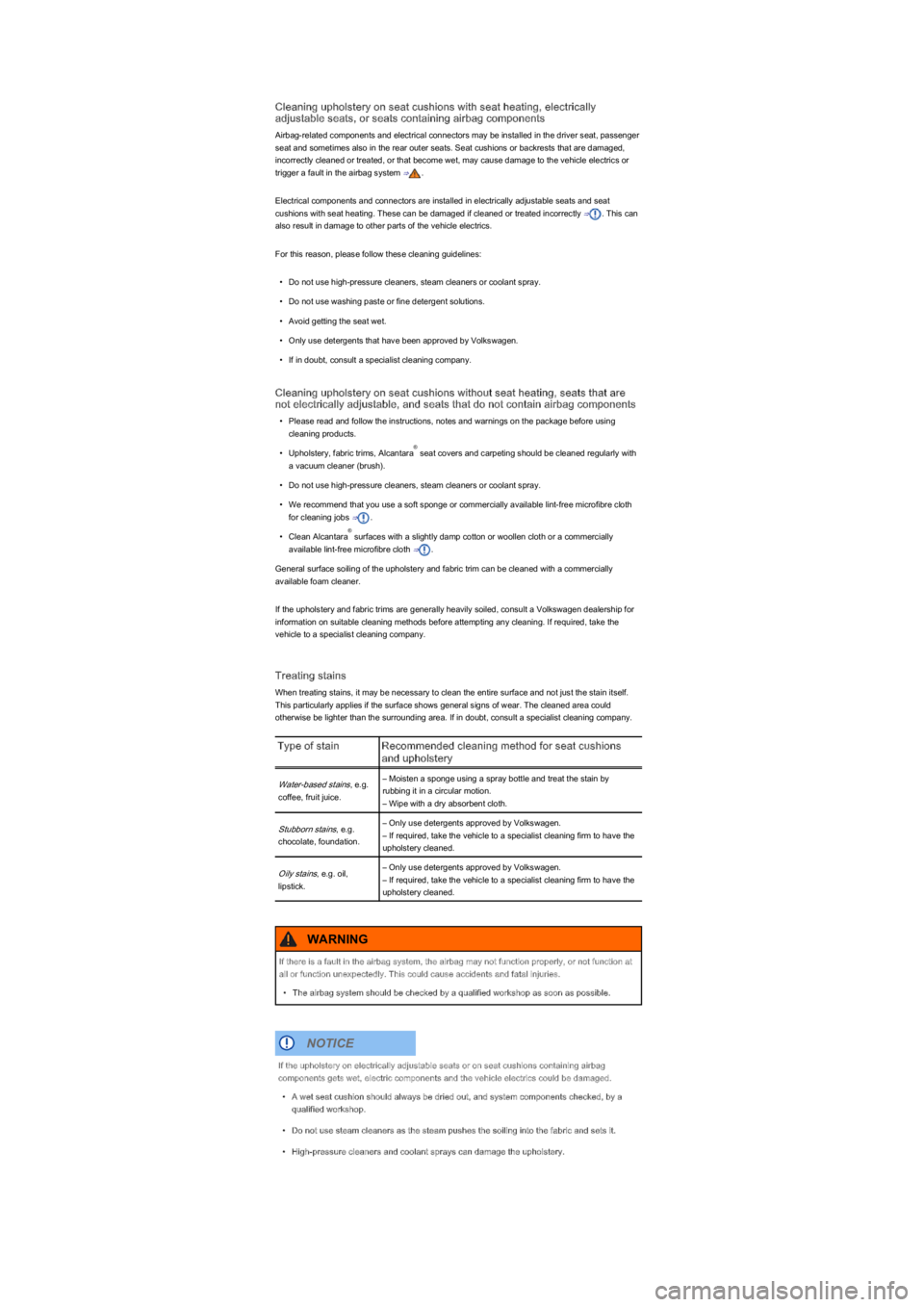
Cleaning upholstery on seat cushions with seat heating, electrically
adjustable seats, or seats containing airbag components
Airbag-related components and electrical connectors may be installed in the driver seat, passenger
seat and sometimes also in the rear outer seats. Seat cushions or backrests that are damaged,
incorrectly cleaned or treated, or that become wet, may cause damage to the vehicle electrics or
trigger a fault in the airbag system ⇒.
Electrical components and connectors are installed in electrically adjustable seats and seat
cushions with seat heating. These can be damaged if cleaned or treated incorrectly ⇒. This can
also result in damage to other parts of the vehicle electrics.
For this reason, please follow these cleaning guidelines:
•Do not use high-pressure cleaners, steam cleaners or coolant spray.
•Do not use washing paste or fine detergent solutions.
•Avoid getting the seat wet.
•Only use detergents that have been approved by Volkswagen.
•If in doubt, consult a specialist cleaning company.
Cleaning upholstery on seat cushions without seat heating, seats that are
not electrically adjustable, and seats that do not contain airbag components
•Please read and follow the instructions, notes and warnings on the package before using
cleaning products.
•Upholstery, fabric trims, Alcantara seat covers and carpeting should be cleaned regularly with
a vacuum cleaner (brush).
•Do not use high-pressure cleaners, steam cleaners or coolant spray.
•We recommend that you use a soft sponge or commercially available lint-free microfibre cloth
for cleaning jobs ⇒.
•Clean Alcantara surfaces with a slightly damp cotton or woollen cloth or a commercially
available lint-free microfibre cloth ⇒.
General surface soiling of the upholstery and fabric trim can be cleaned with a commercially
available foam cleaner.
If the upholstery and fabric trims are generally heavily soiled, consult a Volkswagen dealership for
information on suitable cleaning methods before attempting any cleaning. If required, take the
vehicle to a specialist cleaning company.
Treating stains
When treating stains, it may be necessary to clean the entire surface and not just the stain itself.
This particularly applies if the surface shows general signs of wear. The cleaned area could
otherwise be lighter than the surrounding area. If in doubt, consult a specialist cleaning company.
Type of stainRecommended cleaning method for seat cushions
and upholstery
Water-based stains, e.g.
coffee, fruit juice.
– Moisten a sponge using a spray bottle and treat the stain by
rubbing it in a circular motion.
– Wipe with a dry absorbent cloth.
Stubborn stains, e.g.
chocolate, foundation.
– Only use detergents approved by Volkswagen.
– If required, take the vehicle to a specialist cleaning firm to have the
upholstery cleaned.
Oily stains, e.g. oil,
lipstick.
– Only use detergents approved by Volkswagen.
– If required, take the vehicle to a specialist cleaning firm to have the
upholstery cleaned.
®
®
If there is a fault in the airbag system, the airbag may not function properly, or not function at
all or function unexpectedly. This could cause accidents and fatal injuries.
•The airbag system should be checked by a qualified workshop as soon as possible.
WARNING
If the upholstery on electrically adjustable seats or on seat cushions containing airbag
components gets wet, electric components and the vehicle electrics could be damaged.
•A wet seat cushion should always be dried out, and system components checked, by a
qualified workshop.
•Do not use steam cleaners as the steam pushes the soiling into the fabric and sets it.
•High-pressure cleaners and coolant sprays can damage the upholstery.
NOTICE
Page 155 of 211
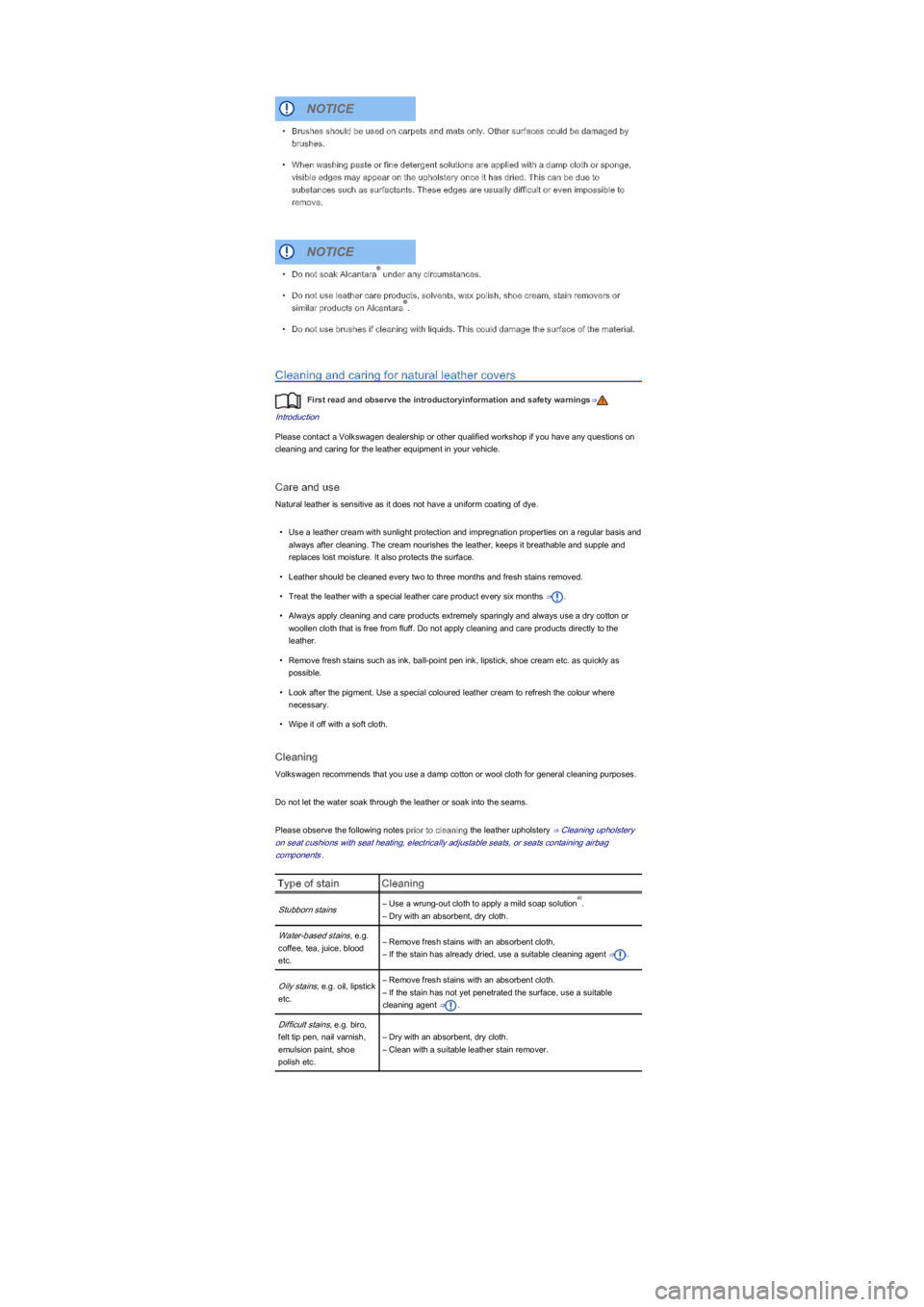
Cleaning and caring for natural leather covers
First read and observe the introductoryinformation and safety warnings⇒
Introduction
Please contact a Volkswagen dealership or other qualified workshop if you have any questions on
cleaning and caring for the leather equipment in your vehicle.
Care and use
Natural leather is sensitive as it does not have a uniform coating of dye.
•Use a leather cream with sunlight protection and impregnation properties on a regular basis and
always after cleaning. The cream nourishes the leather, keeps it breathable and supple and
replaces lost moisture. It also protects the surface.
•Leather should be cleaned every two to three months and fresh stains removed.
•Treat the leather with a special leather care product every six months ⇒.
•Always apply cleaning and care products extremely sparingly and always use a dry cotton or
woollen cloth that is free from fluff. Do not apply cleaning and care products directly to the
leather.
•Remove fresh stains such as ink, ball-point pen ink, lipstick, shoe cream etc. as quickly as
possible.
•Look after the pigment. Use a special coloured leather cream to refresh the colour where
necessary.
•Wipe it off with a soft cloth.
Cleaning
Volkswagen recommends that you use a damp cotton or wool cloth for general cleaning purposes.
Do not let the water soak through the leather or soak into the seams.
Please observe the following notes prior to cleaning the leather upholstery ⇒ Cleaning upholstery
on seat cushions with seat heating, electrically adjustable seats, or seats containing airbag
components.
Type of stainCleaning
Stubborn stains– Use a wrung-out cloth to apply a mild soap solution.
– Dry with an absorbent, dry cloth.
Water-based stains, e.g.
coffee, tea, juice, blood
etc.
– Remove fresh stains with an absorbent cloth,
– If the stain has already dried, use a suitable cleaning agent ⇒.
Oily stains, e.g. oil, lipstick
etc.
– Remove fresh stains with an absorbent cloth.
– If the stain has not yet penetrated the surface, use a suitable
cleaning agent ⇒.
Difficult stains, e.g. biro,
felt tip pen, nail varnish,
emulsion paint, shoe
polish etc.
– Dry with an absorbent, dry cloth.
– Clean with a suitable leather stain remover.
•Brushes should be used on carpets and mats only. Other surfaces could be damaged by
brushes.
•When washing paste or fine detergent solutions are applied with a damp cloth or sponge,
visible edges may appear on the upholstery once it has dried. This can be due to
substances such as surfactants. These edges are usually difficult or even impossible to
remove.
NOTICE
•Do not soak Alcantara under any circumstances.
•Do not use leather care products, solvents, wax polish, shoe cream, stain removers or
similar products on Alcantara.
•Do not use brushes if cleaning with liquids. This could damage the surface of the material.
NOTICE
®
®
a)
Page 168 of 211
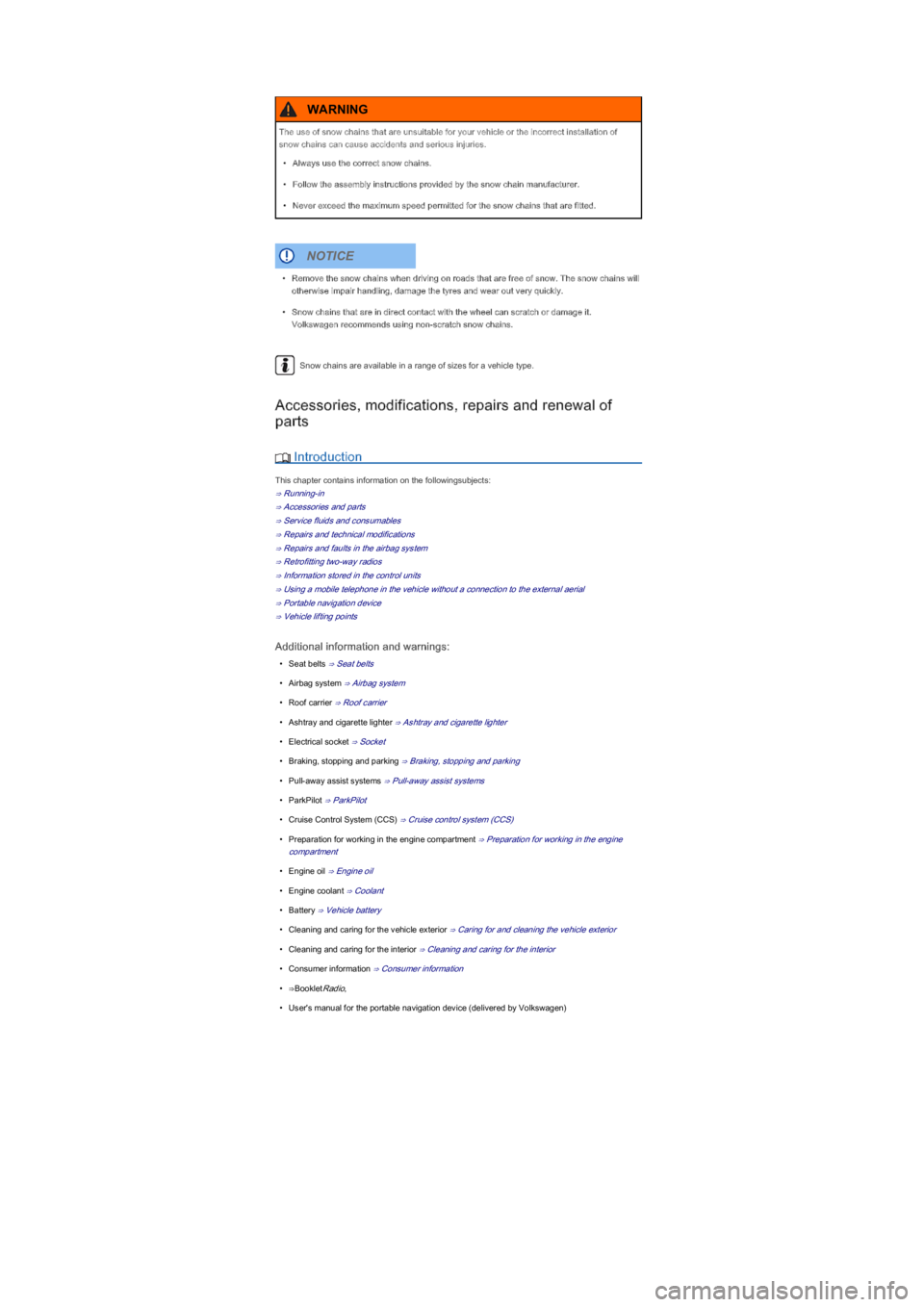
Snow chains are available in a range of sizes for a vehicle type.
Accessories, modifications, repairs and renewal of
parts
Introduction
This chapter contains information on the followingsubjects:
⇒ Running-in
⇒ Accessories and parts
⇒ Service fluids and consumables
⇒ Repairs and technical modifications
⇒ Repairs and faults in the airbag system
⇒ Retrofitting two-way radios
⇒ Information stored in the control units
⇒ Using a mobile telephone in the vehicle without a connection to the external aerial
⇒ Portable navigation device
⇒ Vehicle lifting points
Additional information and warnings:
•Seat belts ⇒ Seat belts
•Airbag system ⇒ Airbag system
•Roof carrier ⇒ Roof carrier
•Ashtray and cigarette lighter ⇒ Ashtray and cigarette lighter
•Electrical socket ⇒ Socket
•Braking, stopping and parking ⇒ Braking, stopping and parking
•Pull-away assist systems ⇒ Pull-away assist systems
•ParkPilot ⇒ ParkPilot
•Cruise Control System (CCS) ⇒ Cruise control system (CCS)
•Preparation for working in the engine compartment ⇒ Preparation for working in the engine
compartment
•Engine oil ⇒ Engine oil
•Engine coolant ⇒ Coolant
•Battery ⇒ Vehicle battery
•Cleaning and caring for the vehicle exterior ⇒ Caring for and cleaning the vehicle exterior
•Cleaning and caring for the interior ⇒ Cleaning and caring for the interior
•Consumer information ⇒ Consumer information
•⇒BookletRadio,
•User's manual for the portable navigation device (delivered by Volkswagen)
The use of snow chains that are unsuitable for your vehicle or the incorrect installation of
snow chains can cause accidents and serious injuries.
•Always use the correct snow chains.
•Follow the assembly instructions provided by the snow chain manufacturer.
•Never exceed the maximum speed permitted for the snow chains that are fitted.
WARNING
•Remove the snow chains when driving on roads that are free of snow. The snow chains will
otherwise impair handling, damage the tyres and wear out very quickly.
•Snow chains that are in direct contact with the wheel can scratch or damage it.
Volkswagen recommends using non-scratch snow chains.
NOTICE
Page 169 of 211
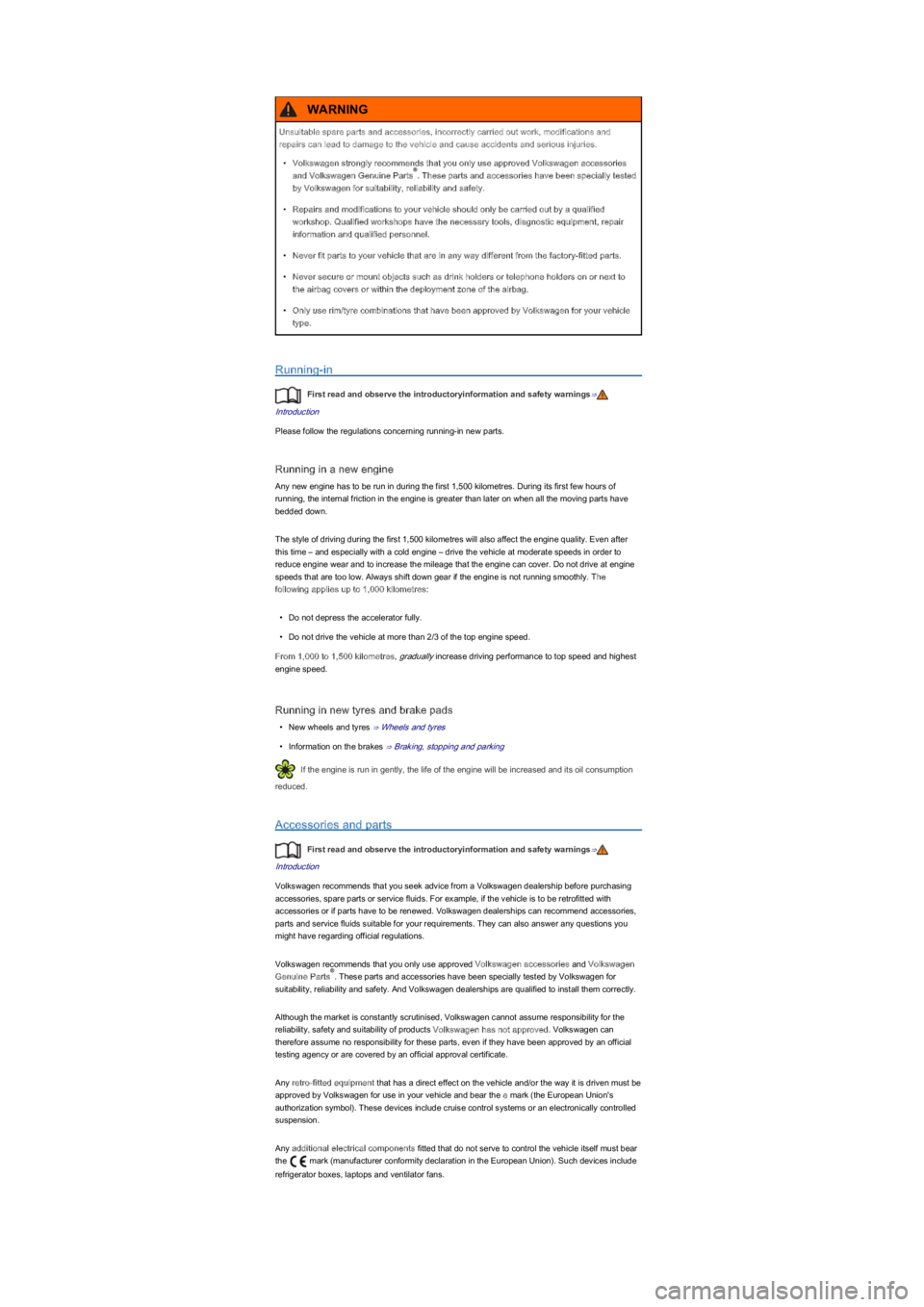
Running-in
First read and observe the introductoryinformation and safety warnings⇒
Introduction
Please follow the regulations concerning running-in new parts.
Running in a new engine
Any new engine has to be run in during the first 1,500 kilometres. During its first few hours of
running, the internal friction in the engine is greater than later on when all the moving parts have
bedded down.
The style of driving during the first 1,500 kilometres will also affect the engine quality. Even after
this time – and especially with a cold engine – drive the vehicle at moderate speeds in order to
reduce engine wear and to increase the mileage that the engine can cover. Do not drive at engine
speeds that are too low. Always shift down gear if the engine is not running smoothly. The
following applies up to 1,000 kilometres:
•Do not depress the accelerator fully.
•Do not drive the vehicle at more than 2/3 of the top engine speed.
From 1,000 to 1,500 kilometres, gradually increase driving performance to top speed and highest
engine speed.
Running in new tyres and brake pads
•New wheels and tyres ⇒ Wheels and tyres
•Information on the brakes ⇒ Braking, stopping and parking
If the engine is run in gently, the life of the engine will be increased and its oil consumption
reduced.
Accessories and parts
First read and observe the introductoryinformation and safety warnings⇒
Introduction
Volkswagen recommends that you seek advice from a Volkswagen dealership before purchasing
accessories, spare parts or service fluids. For example, if the vehicle is to be retrofitted with
accessories or if parts have to be renewed. Volkswagen dealerships can recommend accessories,
parts and service fluids suitable for your requirements. They can also answer any questions you
might have regarding official regulations.
Volkswagen recommends that you only use approved Volkswagen accessories and Volkswagen
Genuine Parts. These parts and accessories have been specially tested by Volkswagen for
suitability, reliability and safety. And Volkswagen dealerships are qualified to install them correctly.
Although the market is constantly scrutinised, Volkswagen cannot assume responsibility for the
reliability, safety and suitability of products Volkswagen has not approved. Volkswagen can
therefore assume no responsibility for these parts, even if they have been approved by an official
testing agency or are covered by an official approval certificate.
Any retro-fitted equipment that has a direct effect on the vehicle and/or the way it is driven must be
approved by Volkswagen for use in your vehicle and bear the e mark (the European Union's
authorization symbol). These devices include cruise control systems or an electronically controlled
suspension.
Any additional electrical components fitted that do not serve to control the vehicle itself must bear
the mark (manufacturer conformity declaration in the European Union). Such devices include
refrigerator boxes, laptops and ventilator fans.
Unsuitable spare parts and accessories, incorrectly carried out work, modifications and
repairs can lead to damage to the vehicle and cause accidents and serious injuries.
•Volkswagen strongly recommends that you only use approved Volkswagen accessories
and Volkswagen Genuine Parts. These parts and accessories have been specially tested
by Volkswagen for suitability, reliability and safety.
•Repairs and modifications to your vehicle should only be carried out by a qualified
workshop. Qualified workshops have the necessary tools, diagnostic equipment, repair
information and qualified personnel.
•Never fit parts to your vehicle that are in any way different from the factory-fitted parts.
•Never secure or mount objects such as drink holders or telephone holders on or next to
the airbag covers or within the deployment zone of the airbag.
•Only use rim/tyre combinations that have been approved by Volkswagen for your vehicle
type.
WARNING
®
®
Page 170 of 211
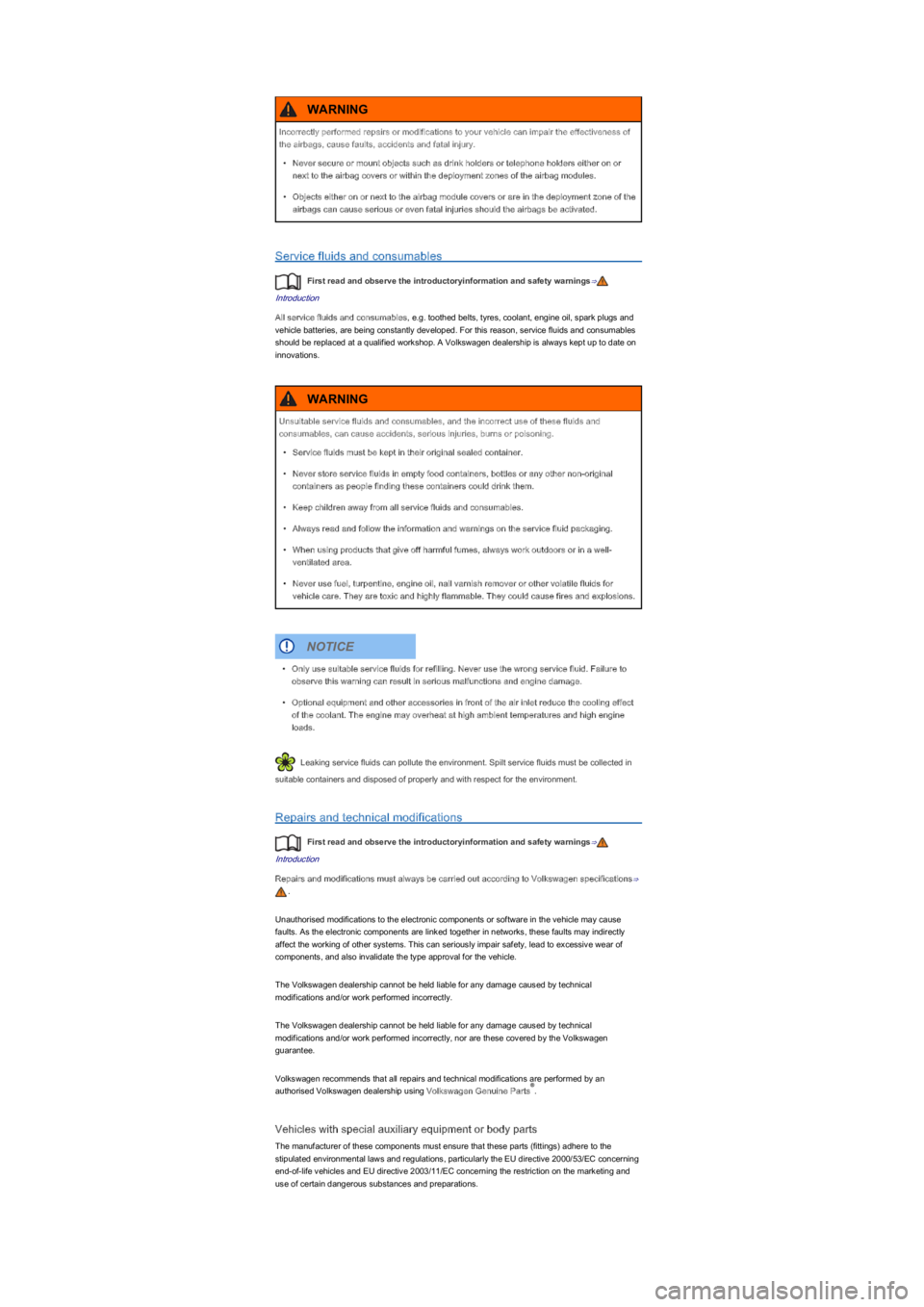
Service fluids and consumables
First read and observe the introductoryinformation and safety warnings⇒
Introduction
All service fluids and consumables, e.g. toothed belts, tyres, coolant, engine oil, spark plugs and
vehicle batteries, are being constantly developed. For this reason, service fluids and consumables
should be replaced at a qualified workshop. A Volkswagen dealership is always kept up to date on
innovations.
Leaking service fluids can pollute the environment. Spilt service fluids must be collected in
suitable containers and disposed of properly and with respect for the environment.
Repairs and technical modifications
First read and observe the introductoryinformation and safety warnings⇒
Introduction
Repairs and modifications must always be carried out according to Volkswagen specifications⇒
.
Unauthorised modifications to the electronic components or software in the vehicle may cause
faults. As the electronic components are linked together in networks, these faults may indirectly
affect the working of other systems. This can seriously impair safety, lead to excessive wear of
components, and also invalidate the type approval for the vehicle.
The Volkswagen dealership cannot be held liable for any damage caused by technical
modifications and/or work performed incorrectly.
The Volkswagen dealership cannot be held liable for any damage caused by technical
modifications and/or work performed incorrectly, nor are these covered by the Volkswagen
guarantee.
Volkswagen recommends that all repairs and technical modifications are performed by an
authorised Volkswagen dealership using Volkswagen Genuine Parts.
Vehicles with special auxiliary equipment or body parts
The manufacturer of these components must ensure that these parts (fittings) adhere to the
stipulated environmental laws and regulations, particularly the EU directive 2000/53/EC concerning
end-of-life vehicles and EU directive 2003/11/EC concerning the restriction on the marketing and
use of certain dangerous substances and preparations.
Incorrectly performed repairs or modifications to your vehicle can impair the effectiveness of
the airbags, cause faults, accidents and fatal injury.
•Never secure or mount objects such as drink holders or telephone holders either on or
next to the airbag covers or within the deployment zones of the airbag modules.
•Objects either on or next to the airbag module covers or are in the deployment zone of the
airbags can cause serious or even fatal injuries should the airbags be activated.
WARNING
Unsuitable service fluids and consumables, and the incorrect use of these fluids and
consumables, can cause accidents, serious injuries, burns or poisoning.
•Service fluids must be kept in their original sealed container.
•Never store service fluids in empty food containers, bottles or any other non-original
containers as people finding these containers could drink them.
•Keep children away from all service fluids and consumables.
•Always read and follow the information and warnings on the service fluid packaging.
•When using products that give off harmful fumes, always work outdoors or in a well-
ventilated area.
•Never use fuel, turpentine, engine oil, nail varnish remover or other volatile fluids for
vehicle care. They are toxic and highly flammable. They could cause fires and explosions.
WARNING
•Only use suitable service fluids for refilling. Never use the wrong service fluid. Failure to
observe this warning can result in serious malfunctions and engine damage.
•Optional equipment and other accessories in front of the air inlet reduce the cooling effect
of the coolant. The engine may overheat at high ambient temperatures and high engine
loads.
NOTICE
®